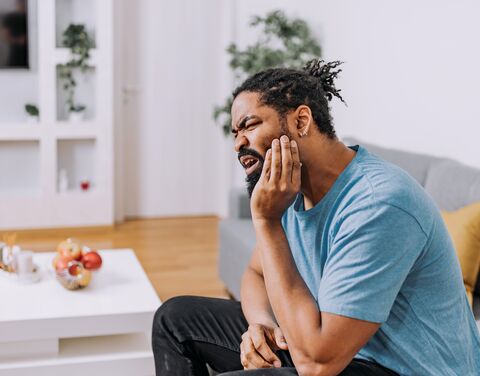
A dental accident can happen at any time and anywhere – whether during sports, at home or if you fall. The consequences of such accidents are often knocked out, broken or loosened teeth. This is painful, but it can also have long-term effects on your oral health – and on your smile.
Whether it’s knocked out teeth after an accident or just a painful mishap, many people ask themselves these same questions: When is it considered a dental accident? Are the teeth insured in the event of an accident? What steps should you take immediately? Who pays? We answer the most important questions.
A dental accident occurs when there is a sudden, unexpected and violent effect on the teeth that results in acute damage.
Such accidents can be caused by various events, such as falls, impacts or other direct effects. Among the most common causes are sports injuries, especially in contact sports such as football, hockey or boxing. Even in everyday life, whether at home, on the road or playing, a fall or collision can quickly lead to a dental accident. Even traffic accidents ,such as car or bicycle accidents, are a common cause of tooth injuries, which often also affect the jaw.
In addition to the above-mentioned accidents, there are also natural causes of damage to the teeth that do not fall under the category of dental accidents:
In Switzerland, dental damage caused by an accident can be insured under certain conditions. For employees, mandatory accident insurance – which is taken out through their employer – generally covers the costs of dental treatment. This insurance covers accidents both at work and during leisure time.
People who are not gainfully employed, such as students, retirees or those who work less than eight hours a week, must include this accident risk in their basic health insurance.
For more comprehensive coverage options, there are private accident or supplementary dental insurance options. These can cover treatments that go beyond the basic benefits of mandatory insurance. For example, aesthetic dental restorations or routine treatments such as annual dental hygiene.
A blow to your tooth can cause a variety of damage: from a slight loosening to severe fractures to completely knocking the tooth out. Here’s what you should do in such a case:
When a tooth wiggles a little in the gums after an accident, but is still anchored to your jaw, this is called a loose tooth. A loose tooth is often the result of a minor trauma, such as a fall or a slight blow. In this case, the tooth does not fall out completely, but such an injury can still cause considerable pain. In many cases, a splint can be used to stabilize the tooth so it can reattach itself again. Taking quick action and a dental examination are essential to avoid any further damage.
A broken tooth can be damaged to varying degrees, from a small chipping to a complete fracture that extends to the root of the tooth. This type of tooth injury often occurs with more severe effects, such as a hard impact or a traffic accident. A broken tooth can be very painful, especially if the tooth nerve is exposed. Depending on the severity of the injury, the tooth may be repaired, given a crown or, in severe cases, a root canal may be necessary.
The most serious form of tooth injury is a knocked out tooth. In this injury, the tooth is completely detached from its socket. Such injuries usually occur in the event of severe blows or falls. It is important to reinsert the tooth as quickly as possible, as the chances of successfully being put back in decrease the longer it is left out. The tooth should be stored in a tooth preservation container, in cold milk or in your own oral cavity and treated by the dentist within 30 minutes and up to a maximum of two hours.
Immediately placing the knocked tooth in the tooth preservation container will protect the root surface from drying out, increasing the chances that a dentist will be able to re-insert the tooth successfully.
A tooth preservation kit is an indispensable tool that can make the difference between losing a tooth and saving a tooth in the event of a dental accident. These special containers are filled with a nutrient solution that can keep knocked out teeth alive for up to 24 hours.
Tooth preservation kits are available from pharmacies and many dentists and should always be included in every first aid kit, especially in households with children.